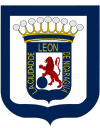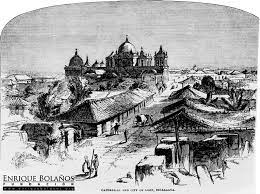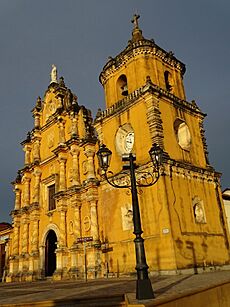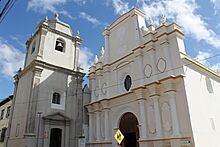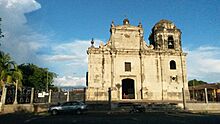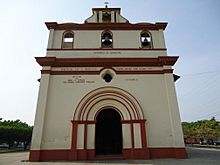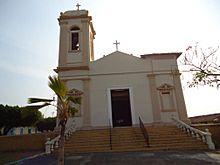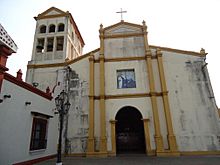León, Nicaragua facts for kids
Quick facts for kids
León
|
|||
|---|---|---|---|
|
Municipality
|
|||
| Santiago de los Caballeros de León | |||

A view of the city towards the Church of the Calvary
|
|||
|
|||
| Country | Nicaragua | ||
| Department | León | ||
| Area | |||
| • Municipality | 820 km2 (320 sq mi) | ||
| Elevation | 109.21 m (358.30 ft) | ||
| Population
(2022 estimate)
|
|||
| • Municipality | 213,718 | ||
| • Density | 260.6/km2 (675/sq mi) | ||
| • Urban | 176,171 (2nd Nicaragua) | ||
| Time zone | UTC-6 (Central (CST)) | ||
León is the second largest city in Nicaragua, right after Managua. The Spanish founded it as Santiago de los Caballeros de León. It is the main city and capital of the León Department. In 2022, the city of León had about 213,718 people living there.
León is located along the Río Chiquito (Chiquito River). It is about 90 kilometers (56 miles) northwest of Managua. It is also about 18 kilometers (11 miles) east of the Pacific Ocean coast.
For a long time, León has been an important center for ideas and government in Nicaragua. Its National Autonomous University of Nicaragua (UNAN) started in 1813. This makes it the second oldest university in Central America.
León is also a key place for farming, business, and industry in Nicaragua. It exports things like sugar cane, cattle, peanuts, plantains, and sorghum. Many famous Nicaraguan poets, like Rubén Darío, Alfonso Cortés, and Salomón de la Selva, came from León.
Contents
History of León
The first city named León in Nicaragua was built in 1524. Francisco Hernández de Córdoba founded it. This first city was about 32 kilometers (20 miles) east of where León is today.
The city was left empty in 1610 after earthquakes and a volcanic eruption. The old city's ruins are called León Viejo. They were found and dug up in 1960. In 2000, UNESCO named León Viejo a World Heritage Site.
León was the capital of Nicaragua for a long time, even during colonial times. When Nicaragua became independent in 1839, León became its capital. For some years, the capital moved back and forth between León and Granada.
People who supported the Liberal party liked León as the capital. Those who supported the Conservative party preferred Granada. To solve this, Fulgencio Vega suggested that Managua become the permanent capital. This happened in 1852.
In 1950, León had about 31,000 people. The Nicaraguan president Anastasio Somoza García was shot in León on September 21, 1956. He later died from his injuries.
Famous Buildings and Places in León
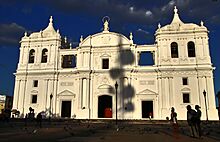
León has many important historical places and buildings. Here are some of them:
- Cárcel la 21 (Prison 21) was a jail in León. It held political prisoners and was a place of harsh treatment. It was built starting in 1910. The National Heroine Blanca Aráuz was held there. During the time of Somoza, it held people who spoke out against the government. The front of the building was damaged in a fight in 1979. Since 2000, it has been an art museum.
- Cathedral Basilica of the Assumption of León is a large church built between 1747 and 1814. It has a strong design that has survived earthquakes, volcano eruptions, and bombings. Cannons were even placed on its roof during wars.
- This Cathedral is the largest church in Central America. It has been the main church for Nicaragua since 1531. Many important people are buried in its crypts (underground rooms). These include the famous poet Rubén Darío. He was a very important writer in the Spanish-speaking world. Other poets like Salomón de la Selva and Alfonso Cortés are also buried there.
- There are tunnels that connect the cathedral to other churches. These were used as hiding places or escape routes during attacks by pirates. However, visitors cannot go into these tunnels today.
- Church of Sutiava is the oldest church in León that is still standing. Its construction began in 1698 and finished in 1710. Its tower was damaged in a war in 1844 but was rebuilt. The neighborhood officially changed the spelling of its name to "Sutiava."
- Church of San Francisco is part of a very old convent built in 1639. It has beautiful altars inside. Its main feature is a peaceful courtyard with a fountain and lemon trees.
- Church of la Recolección started being built in 1786. Its front (façade) is in a Mexican baroque style and is very important in the city. The inside has a beautiful altar with paintings.
- Church of la Merced was built in the 18th century. Next to it is the Paraninfo building, which was once a convent. It is now the main office building for the UNAN university.
- Church of el Calvario is known for its colorful and detailed design. It has a central part painted yellow with white trim. The two bell towers are red with white details. This church was built in the 18th century and is a beautiful example of León's architecture.
- Ruins of the Church of San Sebastián was built in the late 1600s. It was damaged during the revolution in 1979. Because it was made of adobe bricks, it was easily destroyed, unlike other churches made of stronger materials.
- Church of Guadalupe was built in the late 1800s. It replaced an older chapel. It has a simple design.
- Church of Zaragoza started being built in the late 1800s and finished in the mid-1900s.
- Church of San Felipe is a large building that takes up a whole city block. It was built in 1685. It was expanded in 1859 to look as it does today.
- Church Hermitage of San Pedro is a small, typical 18th-century building. It was built between 1706 and 1718.
- Church of San Nicolás Tolentino del Laborío was ordered to be built in 1618. It has a light, colonial baroque style.
- Chapel of la Asunción is part of a school. It was built in 1679 and was once a bishop's palace. In 1935, it was changed to its current look, mixing old colonial style with a newer Gothic style.
- City Hall was built in 1935. It was damaged during the 1979 revolution. The building has an Art Deco style and is an important piece of architecture.
Other interesting places include the Guadalupe Cemetery walls, Guadalupe Bridge, the Debayle Museum, and the old Train Station.
- León Viejo are the ruins of the first city of León. It was buried by an eruption of the Momotombo volcano in 1610. It is about 30 kilometers (19 miles) from the current city of León. It is a World Heritage Site. The city's founder, Francisco Hernández de Córdoba, is buried there.
Geography and Nature Around León
Leon is in the lowlands near the coast in northwestern Nicaragua. You can see volcanoes and hills of the central highlands to the east. The average temperature is about 27.9 degrees Celsius (82.2 degrees Fahrenheit). The area gets about 1902 millimeters (75 inches) of rain each year.
Here are some natural places near León:
- Poneloya beach is a popular place for tourists on the Pacific Ocean.
- San Jacinto Swarms is a geothermal area. This means there are hot springs and steam vents coming from the ground near the Santa Clara volcano.
- Momotombo volcano is about 1,300 meters (4,265 feet) tall. It is a famous landmark in the area. The old city of León Viejo is at its base. The name "Momotombo" means "Great Summit Burning" in a Native American language. There is a power plant that uses the volcano's heat to make energy.
- Cerro Negro volcano is one of the youngest volcanoes in the world, formed in 1850. It has caused problems for León many times. It has had eruptions with lots of ash, like the one in 1995.
Notable People from León
- José de la Cruz Mena, a classical music composer (1874–1907).
- Azarías Pallais, a poet and writer (1884–1954).
- Alfonso Cortés, a poet (1893–1969).
- Salomón of the Jungle, a poet, writer, and diplomat (1893–1959).
- Antenor Sandino, a poet (1899–1969).
- Anastasio Somoza Debayle, a former president of Nicaragua (1967–1972, 1974–1979).
- Enrique Bermúdez, a Contra leader (1932–1991).
- Dr. Jose Venancio Berrios Obregon, founder of Las Penitas Beach (1960).
- Madre Adela Galindo.
- José Areas, a percussionist who played timbales in the band Santana (born 1946).
León's Sister Cities
León has "sister city" relationships with other cities around the world. This helps them share culture and ideas.
|
|
Images for kids
See also
 In Spanish: León (Nicaragua) para niños
In Spanish: León (Nicaragua) para niños



